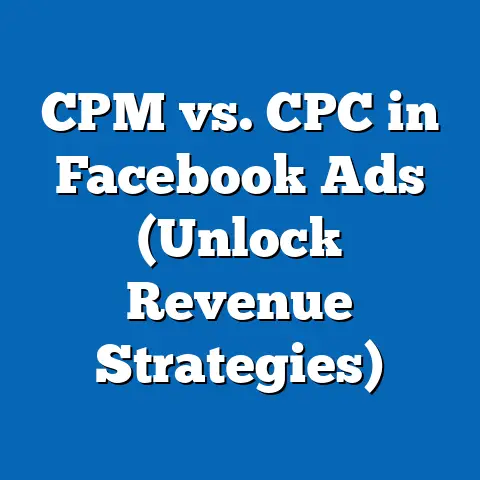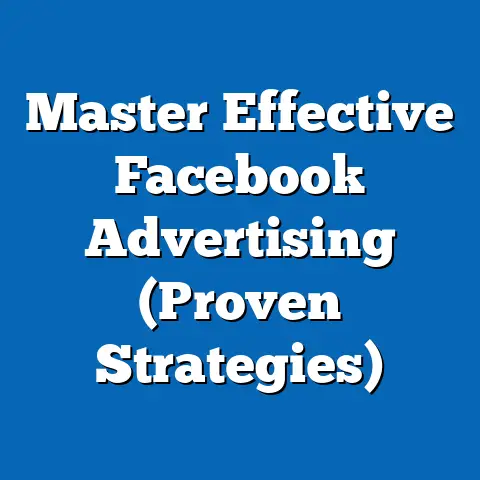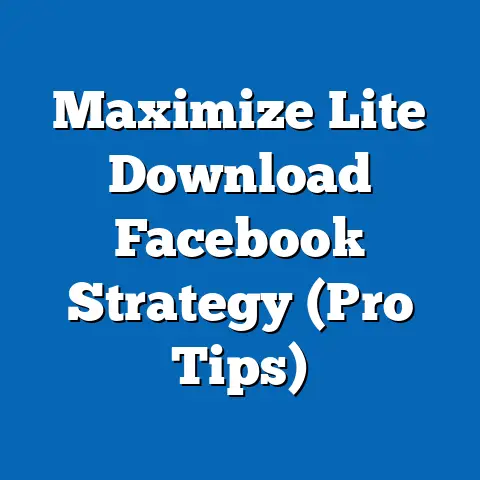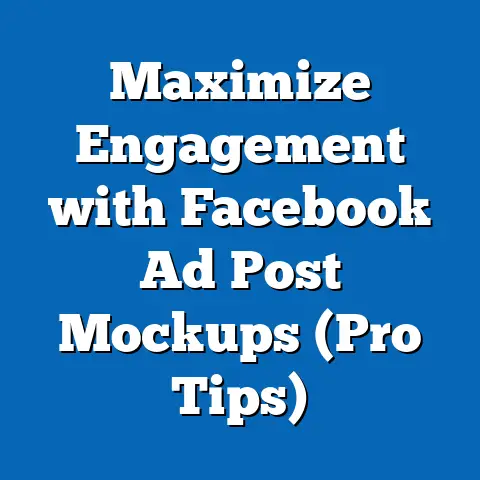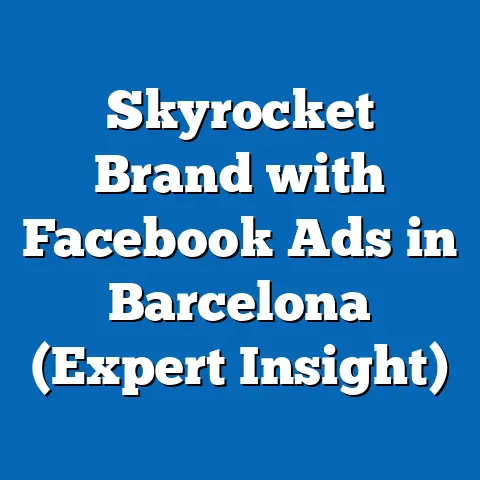Mastering Tofu Facebook Ads (Proven Strategies for Success)
In the ever-evolving landscape of digital marketing, a niche yet fiercely competitive arena has emerged—one that might surprise even the savviest of advertisers: tofu. Yes, this humble plant-based protein, once relegated to health food stores and vegetarian menus, has become a cultural and culinary phenomenon, sparking heated debates and passionate loyalties across generations and demographics. As tofu surges in popularity, driven by health-conscious millennials, eco-aware Gen Z, and even curious Boomers, the battle to capture consumer attention on platforms like Facebook has reached a fever pitch.
Tofu is no longer just a food; it is a symbol of sustainability, wellness, and dietary revolution. Its rise reflects broader societal shifts toward plant-based diets, with the global tofu market projected to grow at a compound annual growth rate (CAGR) of 6.5% from 2023 to 2030, according to market research by Grand View Research. This growth has turned tofu into a marketing goldmine, but also a minefield, where brands must navigate cultural sensitivities, dietary preferences, and fierce competition to stand out in a crowded social media feed.
The historical context of tofu’s journey is as rich as its protein content. Originating over 2,000 years ago in China, tofu spread across Asia as a dietary staple before making its way to Western markets in the 20th century, often met with skepticism as a “hippie” food. Today, its societal implications are profound—representing not just a shift in eating habits but a response to climate change, animal welfare concerns, and health crises like obesity and heart disease. As brands leverage Facebook ads to tap into this zeitgeist, mastering the art of tofu marketing has become a critical skill, with implications for how we understand consumer behavior, digital strategy, and even generational divides in the modern era.
Section 1: The Rise of Tofu as a Cultural and Market Force
Historical Roots and Modern Resurgence
Tofu’s story begins in ancient China, where it was first documented during the Han Dynasty as a nutritious, affordable protein source. For centuries, it remained a cornerstone of Asian cuisine, embodying values of simplicity and sustainability long before these became global buzzwords. Its migration to the West, particularly during the 1960s and 1970s, aligned with the counterculture movement, where it was embraced by vegetarians and health enthusiasts amid growing awareness of industrial farming’s environmental toll.
Fast forward to the 21st century, and tofu has shed its niche status to become a mainstream staple. The rise of veganism, propelled by documentaries like Cowspiracy (2014) and The Game Changers (2018), has catapulted plant-based foods into the spotlight. According to a 2021 report by Bloomberg Intelligence, the plant-based food market could reach $162 billion by 2030, with tofu as a key player due to its versatility and accessibility.
This resurgence is not just economic but deeply cultural. Tofu has become a canvas for culinary innovation, appearing in everything from vegan burgers to desserts, while also serving as a lightning rod for debates about tradition versus modernity in food culture. For marketers, this dual identity—rooted in heritage yet forward-looking—presents unique opportunities and challenges when crafting messages for diverse audiences on platforms like Facebook.
Societal Implications and Generational Appeal
Tofu’s modern appeal spans generations, but its resonance varies significantly across age groups. Millennials (born 1981–1996), often driven by health and ethical concerns, have been instrumental in normalizing plant-based diets, with 31% identifying as flexitarian or vegetarian, per a 2020 Gallup poll. Gen Z (born 1997–2012), meanwhile, prioritizes sustainability, with 73% willing to change their consumption habits to reduce environmental impact, according to a 2022 McKinsey study.
Baby Boomers (born 1946–1964) and Gen X (born 1965–1980) present a more complex picture. While some adopt tofu for health reasons—particularly as heart disease and diabetes rates climb—others remain skeptical, associating it with unfamiliar or “trendy” diets. These generational nuances underscore the importance of tailored messaging in Facebook ads, where a one-size-fits-all approach risks alienating key demographics.
Beyond individual preferences, tofu’s rise reflects broader societal shifts. It embodies the push for sustainable food systems amid climate change, with livestock farming accounting for 14.5% of global greenhouse gas emissions, per the FAO. It also signals a move toward personalized health, as consumers seek alternatives to processed meats. For brands, positioning tofu within these larger narratives—whether as a planet-saving hero or a wellness booster—is critical to resonating with today’s socially conscious consumers.
Section 2: Why Facebook Ads? The Digital Playground for Tofu Brands
The Power of Social Media in Food Marketing
Facebook remains a titan in the digital advertising world, boasting 2.9 billion monthly active users as of 2023, according to Meta’s own reports. Its unparalleled reach, combined with sophisticated targeting tools, makes it an ideal platform for niche products like tofu, which require precise audience segmentation to maximize impact. Unlike broader platforms like television, Facebook allows brands to zero in on specific demographics, interests, and behaviors—whether targeting vegan moms in suburban areas or eco-activists on college campuses.
Food marketing, in particular, thrives on social media due to its visual and communal nature. A 2022 study by Sprout Social found that 68% of consumers follow food brands on social platforms, often seeking recipes, reviews, and inspiration. Tofu, with its photogenic potential in vibrant dishes, lends itself perfectly to scroll-stopping visuals—a key driver of engagement on Facebook.
Moreover, Facebook’s algorithm favors content that sparks interaction, making community-building a powerful tool for tofu brands. User-generated content, such as recipe shares or testimonials, can amplify a campaign’s reach organically, reducing reliance on paid ads alone. This dynamic interplay of paid and organic strategies is where tofu marketing can truly shine—if executed with precision.
Challenges in the Digital Space
Despite its advantages, Facebook advertising is not without hurdles. The platform’s ad space is notoriously crowded, with brands across industries vying for attention in users’ feeds. For tofu marketers, standing out requires more than a pretty picture; it demands a deep understanding of audience pain points, cultural trends, and competitive positioning.
Additionally, ad fatigue is a real concern. Consumers are bombarded with promotions daily, leading to banner blindness or outright annoyance. A 2021 survey by eMarketer revealed that 47% of users skip ads unless they feel personally relevant. For tofu brands, this means relevance is non-negotiable—whether through hyper-targeted campaigns or authentic storytelling that transcends mere product promotion.
Finally, the ethical dimension of tofu marketing on Facebook cannot be ignored. Misleading claims about health benefits or sustainability can backfire, especially among savvy younger audiences who value transparency. Brands must balance persuasion with integrity, ensuring their ads align with verifiable facts and genuine brand values.
Section 3: Proven Strategies for Tofu Facebook Ads Success
Strategy 1: Know Your Audience—Generational Targeting
Effective tofu ads begin with a granular understanding of generational preferences, as each cohort engages with food and technology differently. Millennials, for instance, respond well to ads emphasizing health benefits and ethical sourcing, often engaging with content that includes personal stories or influencer endorsements. A campaign targeting this group might feature a millennial chef sharing a quick tofu stir-fry recipe, paired with stats on protein content or carbon footprint reduction.
Gen Z, on the other hand, craves authenticity and social impact. Ads for this demographic should highlight sustainability credentials—perhaps showcasing a brand’s commitment to zero-waste packaging or local farming. Interactive formats like polls (“What’s your favorite tofu dish?”) or challenges (e.g., a 7-day plant-based challenge) can boost engagement, as Gen Z values participation over passive consumption.
For older generations like Gen X and Boomers, simplicity and practicality reign supreme. Ads targeting these groups might focus on tofu as an easy, heart-healthy alternative to meat, with clear instructions for preparation. A video ad demonstrating a familiar dish—like tofu meatballs—can bridge the gap between curiosity and action, addressing potential hesitancy with approachable content.
Strategy 2: Visual Storytelling and Emotional Connection
Tofu may lack the inherent glamour of steak or chocolate, but its visual potential is vast when paired with the right narrative. High-quality images or videos of tofu dishes—think golden crispy nuggets or creamy tofu cheesecake—can evoke hunger and curiosity, key triggers for food-related engagement. A 2020 study by HubSpot found that video content on social media generates 12 times more shares than text and images combined, underscoring the power of dynamic visuals.
Beyond aesthetics, emotional storytelling is a game-changer. Ads that connect tofu to broader themes—like family meals, environmental stewardship, or personal transformation—resonate on a deeper level. For example, a campaign might depict a parent cooking tofu for their child as a gesture of care for both health and the planet, tapping into universal values of love and responsibility.
Cultural sensitivity is also critical in storytelling. Tofu holds different meanings across communities—revered as a traditional staple in some Asian cultures, yet misunderstood as a “foreign” food in others. Ads must navigate these nuances, celebrating tofu’s heritage while making it accessible to diverse palates. A misstep here risks alienating audiences, as seen in past campaigns criticized for cultural appropriation or stereotyping.
Strategy 3: Data-Driven Targeting and Retargeting
Facebook’s ad platform offers unparalleled targeting capabilities, from demographic filters to interest-based audiences. Tofu brands can leverage this by creating custom audiences—such as users who follow vegan pages, engage with health content, or shop at organic stores. Lookalike audiences, which mirror the traits of existing customers, can further expand reach without sacrificing relevance.
Retargeting is equally vital, especially for a product like tofu that may require multiple touchpoints before purchase. A user who clicks on a tofu recipe ad but doesn’t convert can be retargeted with a discount code or a testimonial video, gently nudging them toward action. According to a 2021 report by AdRoll, retargeted users are 70% more likely to convert, making this a cost-effective strategy for sustained engagement.
A/B testing is another cornerstone of data-driven success. By experimenting with different ad formats (carousel vs. single image), copy tones (humorous vs. serious), or calls-to-action (“Shop Now” vs. “Learn More”), brands can identify what resonates most with their audience. Continuous optimization based on metrics like click-through rates (CTR) and cost-per-acquisition (CPA) ensures campaigns remain agile in a fast-paced digital environment.
Strategy 4: Community Building and User-Generated Content
Tofu’s versatility makes it ripe for community-driven campaigns, where fans share their own recipes, tips, or photos. Encouraging user-generated content (UGC) not only boosts authenticity but also extends a brand’s reach, as users are more likely to trust peer recommendations over polished ads. A 2022 Stackla survey found that 79% of consumers say UGC highly impacts their purchasing decisions.
Brands can incentivize UGC through contests—e.g., “Share your best tofu dish for a chance to win a year’s supply!”—or by featuring fan content on their pages. This fosters a sense of belonging, turning casual buyers into loyal advocates. For instance, a small tofu brand might create a Facebook group for plant-based cooks, positioning itself as a facilitator of community rather than just a seller.
Influencer partnerships can amplify these efforts, especially with micro-influencers who command niche, engaged followings. A vegan food blogger with 10,000 followers may drive more meaningful engagement than a celebrity with millions, as their audience trusts their expertise. Authenticity remains key; forced or overly commercial partnerships can erode credibility, particularly among discerning younger users.
Strategy 5: Addressing Pain Points and Overcoming Barriers
Tofu’s biggest marketing challenge is perception. Many consumers view it as bland, difficult to cook, or culturally inaccessible—a barrier that ads must proactively address. Educational content, such as quick tutorials on marinating tofu or debunking myths (“Tofu doesn’t have to be boring!”), can demystify the product for hesitant buyers.
Price sensitivity is another hurdle, especially as premium or organic tofu brands often carry higher price tags. Ads can counter this by emphasizing value—highlighting tofu’s cost-per-serving compared to meat or its longevity in meal prep. Promotions like bundle deals or first-purchase discounts can also lower the entry barrier, encouraging trial among skeptics.
Finally, addressing dietary concerns is crucial. Some consumers worry about soy’s impact on hormones or allergies, despite scientific consensus (e.g., from the American Cancer Society) that moderate soy consumption is safe for most people. Transparent ads that link to credible sources or feature expert endorsements can build trust, turning skepticism into confidence.
Section 4: Case Studies—Learning from Success and Failure
Success Story: A Small Brand’s Viral Campaign
In 2021, a small tofu company, GreenSoy, launched a modest Facebook ad campaign targeting local vegan communities. Their strategy was simple yet effective: a series of short, humorous videos showing “tofu fails” (e.g., crumbling blocks) followed by easy fixes, paired with a hashtag challenge (#TofuTurnaround). The campaign garnered over 500,000 views and a 15% increase in online sales within three months, per the company’s public reports.
GreenSoy’s success lay in its relatability and interactivity. By acknowledging common frustrations, they connected emotionally with viewers, while the challenge encouraged UGC, amplifying their reach. This case underscores the power of authenticity and community engagement, even for brands with limited budgets.
Cautionary Tale: A Misstep in Cultural Messaging
Conversely, a larger brand faced backlash in 2020 after releasing an ad that portrayed tofu as an “exotic” alternative to “normal” food, featuring stereotypical imagery of Asian culture. The ad sparked criticism on Facebook, with users accusing the brand of cultural insensitivity. Engagement plummeted, and the company issued a public apology, pulling the campaign within days.
This failure highlights the importance of cultural competence in tofu marketing. Ads must respect the product’s heritage while avoiding clichés or tokenism. It also illustrates the speed at which social media can amplify missteps, necessitating thorough pre-launch testing and diverse input in creative processes.
Section 5: Implications for Society, Culture, and Business
Cultural Shifts and Generational Dialogue
Tofu Facebook ads are more than a marketing tool; they are a microcosm of broader cultural shifts. By promoting plant-based eating, these campaigns contribute to ongoing dialogues about sustainability, health, and ethics—issues that resonate differently across generations. They also bridge cultural divides, introducing traditional foods to new audiences while challenging stereotypes about diet and identity.
For younger generations, these ads reinforce values of activism and individuality, often framing tofu as a rebellion against outdated norms. For older cohorts, they offer a gateway to modern eating without alienation, provided the messaging feels inclusive. This generational interplay shapes not just consumption but how society grapples with change in food systems.
Workplace and Marketing Industry Impacts
In the business realm, mastering tofu ads on Facebook signals a shift toward niche, values-driven marketing. Companies must invest in data literacy, cultural awareness, and creative agility to stay competitive, reshaping hiring needs and training programs. Marketers skilled in social listening and cross-generational communication are increasingly in demand, as are tools for real-time campaign analysis.
Moreover, success in this space can redefine brand loyalty. Tofu consumers often align with brands that share their principles, creating opportunities for long-term relationships over transactional sales. This trend pushes companies to prioritize purpose alongside profit—a lesson applicable far beyond food marketing.
Economic and Environmental Ripple Effects
Economically, the tofu boom fuels growth in agriculture, manufacturing, and digital advertising sectors, creating jobs and innovation opportunities. Environmentally, promoting tofu over meat aligns with global goals like the Paris Agreement, reducing carbon footprints one meal at a time. However, challenges remain, such as ensuring sustainable soy sourcing to avoid deforestation—a concern ads must address transparently.
Facebook campaigns play a pivotal role here, educating consumers on these complex issues while driving demand for ethical products. Their influence extends to policy, as increased tofu adoption could pressure governments to support plant-based incentives, reshaping food economies on a macro scale.
Section 6: Conclusion—Looking Ahead in Tofu Digital Marketing
Mastering tofu Facebook ads is both an art and a science, requiring a delicate balance of creativity, data, and cultural insight. As we’ve explored, proven strategies include generational targeting, visual storytelling, data-driven optimization, community engagement, and barrier-breaking education. These approaches not only drive sales but also position brands as leaders in a transformative food movement, resonating with consumers across diverse backgrounds.
Looking forward, the landscape remains dynamic. Emerging technologies like AI-driven ad personalization and augmented reality (e.g., “try this tofu dish in 3D”) could redefine engagement, while evolving privacy regulations may challenge targeting precision. Generational shifts will also play a role, as Gen Alpha (born 2013–present) enters the consumer space with digital fluency and eco-consciousness baked into their worldview.
Uncertainties abound—will tofu maintain its momentum, or will new plant-based alternatives steal the spotlight? Can brands sustain authenticity as competition intensifies? While answers remain elusive, one thing is clear: tofu marketing on Facebook is a proving ground for broader trends in digital strategy and societal change. By staying attuned to generational nuances, cultural currents, and technological advances, brands can not only master this niche but also shape the future of how we eat, think, and connect in a digital age.
In the end, tofu is more than a product—it’s a lens through which we view our values, challenges, and aspirations. And in the hands of skilled marketers, a well-crafted Facebook ad can turn a humble soy block into a powerful catalyst for change. As the digital battleground evolves, the question remains: how will your brand rise to the occasion?

